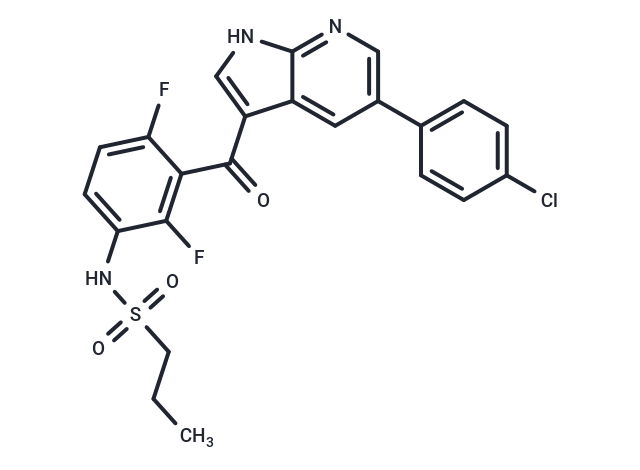Shopping Cart
- Remove All
 Your shopping cart is currently empty
Your shopping cart is currently empty
Vemurafenib (RG7204) is a B-RAF inhibitor that inhibits RAFV600E and c-RAF-1 (IC50=31/48 nM) selectively and potently. Vemurafenib exhibits antitumor activity and is used for the treatment of BRAF V600E mutation-positive melanoma.

| Pack Size | Price | Availability | Quantity |
|---|---|---|---|
| 10 mg | $50 | In Stock | |
| 50 mg | $72 | In Stock | |
| 100 mg | $100 | In Stock | |
| 200 mg | $180 | In Stock | |
| 500 mg | $306 | In Stock | |
| 1 mL x 10 mM (in DMSO) | $50 | In Stock |
| Description | Vemurafenib (RG7204) is a B-RAF inhibitor that inhibits RAFV600E and c-RAF-1 (IC50=31/48 nM) selectively and potently. Vemurafenib exhibits antitumor activity and is used for the treatment of BRAF V600E mutation-positive melanoma. |
| Targets&IC50 | B-Raf (V600E):31 nM (cell free), C-Raf1:48 nM (cell free), Ack1:19 nM (cell free), SRMS:18 nM (cell free) |
| In vitro | METHODS: Melanoma cells A375 and SK-Mel-28 were treated with Vemurafenib (0-8 μM) for 48 h. Cell viability was detected using CCK-8 assay. RESULTS: Vemurafenib dose-dependently inhibited the proliferation of A375 and SK-Mel-28 cells with IC50 of 0.8 μM and 1.8 μM, respectively.[1] METHODS: Melanoma cell lines Colo829 and LOX expressing BRAF V600E were treated with Vemurafenib (0.05-30 μmol/L) for 2 h, and the expression levels of target proteins were detected by Western Blot. RESULTS: Vemurafenib inhibited the phosphorylation of MEK and ERK in Colo829 and LOX cells. [2] |
| In vivo | METHODS: To assay anti-tumor activity in vivo, Vemurafenib (12.5-75 mg/kg, suspended in an aqueous vehicle containing 2% Klucel LF and adjusted to pH 4 with dilute HCl.) was orally administered to melanoma-carrying Athymic nude mice bearing LOX were administered orally twice daily for 11-13 days. RESULTS: Vemurafenib significantly inhibited tumor growth and induced tumor regression. [2] METHODS: In order to detect the anti-tumor activity in vivo, Vemurafenib (60 mg/kg) was administered orally to athymic mice bearing melanoma Colo-205 twice a day for 14 days. RESULTS: Vemurafenib effectively inhibited tumor growth in the Colo-205 xenograft mouse model. [3] |
| Kinase Assay | Expression and purification of B-RAF, structure determination, and protein kinase activity measurements were carried out as previously described. To obtain co-crystals of B-RAFV600E with PLX4032, the protein solution was initially mixed with the compound dissolved in DMSO at a final compound concentration of 1 mM. This complex was co-crystallized by a sitting drop vapor diffusion experiment in which equal volumes of complex (at 10 mg/ml concentration) and reservoir solution (100mM BisTris at pH 6.0, 12.5% 2,5-hexanediol, and 12% PEG3350) were mixed and allowed to equilibrate against the reservoir at 4°C. The crystal was soaked in cryosolvent, followed by flash-freezing in liquid nitrogen. The data were collected at Beamline ALS831 with the wavelength of 1.11?. The Ramachandran plot from the refined structure shows that 94%, 5.6% and 0.4% residues are in the most favored, additional allowed and generously allowed regions, respectively. A summary of the crystallography statistics is included in Supplementary Table 3. COLO205 tumor xenograft studies (Molecular Imaging Research, Ann Arbor, MI) were carried out as previously described either using a conventional formulation (5%DMSO, 1% methylcellulose) or using the MBP formulation [1]. |
| Cell Research | Cellular proliferation was evaluated by MTT assay. Briefly, cells were plated in 96-well microtiter plates at a density of 1,000 to 5,000 cells per well in a volume of 180 μL. For the assay, RG7204 was prepared at 10 times the final assay concentration in media containing 1% DMSO. Twenty-four hours after cell plating, 20 μL of the appropriate dilution were added to plates in duplicate. The plates were assayed for proliferation 6 days after the cells were plated according to the procedure originally described by Mosmann [2]. |
| Animal Research | All animal procedures were approved by the Ethical Commission of the Institute for Cancer Research and Treatment and by the Italian Ministry of Health. WiDr cells were injected subcutaneously into the right posterior flanks of 7-week-old immunodeficient NODSCID female mice (6 mice per group). Tumour formation was monitored twice a week, and tumour volume based on caliper measurements was calculated by the modified ellipsoidal formula: tumour volume = 1/2 length × width. When tumours reached a volume of approximately 200–250 mm^3, mice were randomly assigned to treatment with vehicle or drug(s) [3]. |
| Synonyms | RO5185426, RG7204, PLX4032 |
| Molecular Weight | 489.92 |
| Formula | C23H18ClF2N3O3S |
| Cas No. | 918504-65-1 |
| Smiles | C(=O)(C=1C=2C(NC1)=NC=C(C2)C3=CC=C(Cl)C=C3)C4=C(F)C(NS(CCC)(=O)=O)=CC=C4F |
| Relative Density. | 1.46 g/cm3 |
| Storage | Powder: -20°C for 3 years | In solvent: -80°C for 1 year | Shipping with blue ice/Shipping at ambient temperature. | |||||||||||||||||||||||||||||||||||
| Solubility Information | Ethanol: < 1 mg/mL (insoluble or slightly soluble) H2O: < 1 mg/mL (insoluble or slightly soluble) DMSO: 99 mg/mL (202.07 mM), Sonication is recommended. | |||||||||||||||||||||||||||||||||||
| In Vivo Formulation | 10% DMSO+40% PEG300+5% Tween 80+45% Saline: 9 mg/mL (18.37 mM), Suspension. Please add the solvents sequentially, clarifying the solution as much as possible before adding the next one. Dissolve by heating and/or sonication if necessary. Working solution is recommended to be prepared and used immediately. The formulation provided above is for reference purposes only. In vivo formulations may vary and should be modified based on specific experimental conditions. | |||||||||||||||||||||||||||||||||||
Solution Preparation Table | ||||||||||||||||||||||||||||||||||||
DMSO
| ||||||||||||||||||||||||||||||||||||

Copyright © 2015-2025 TargetMol Chemicals Inc. All Rights Reserved.